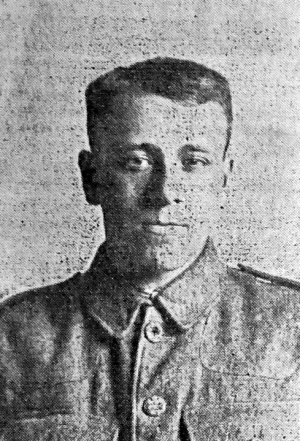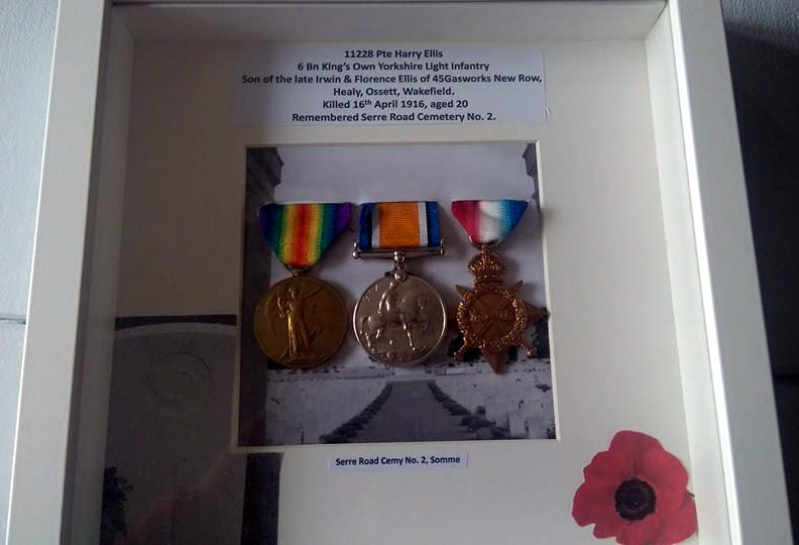
Harry Ellis was born in Ossett in 1896, the son of Erwin Ellis and Florence Annie (nee Scott) who were married in Ossett in 1889. In 1901, Erwin is working as a mason’s labourer and the Ellis family are living at Healey, Ossett with three children: Evelyn, Annie and the Harry, who is the youngest.
Harry’s mother, Florence died in 1903, aged 34, and in 1911, Harry is living at 45, Gasworks Row, Healey with his widower father Erwin who is now a Gas Stoker working for the Borough Council. Harry, aged 15 is at Secondary School. Neither of Erwin’s girls are in the household, but 19 year old Annie is a general servant living in the Leeds Union Workhouse on Beckett Street Leeds. Erwin Ellis died in 1929.
Private Harry Ellis, of Gasworks Row, Healey, Ossett was killed in action on the 16th August 1916. He was only 20 years old, and was one of the first Ossett men to enlist after the war broke out, joining up in the first month. Before the war he had worked at the gasworks as a blacksmith’s striker. His father, Erwin Ellis, also worked at the gasworks as a stoker. 1
Harry’s parents received the news of his death in a letter sent to them by Corporal Pentelow of the machine gun section, attached to the King’s Own Yorkshire Light Infantry. He stated that his death had occurred at 3:20 am, by the explosion of a large calibre shell. His death had been instant. Harry’s brigade had made an attack the previous day, and it was during the counter-attack, which happened in the night, that Harry was killed. Corporal Pentelow went on to say of Harry Ellis:
“As a comrade, your son was a pleasant and obliging companion. As a gunner, he had not had an equal in his battalion. His heart was in his work, and all his spare bits of paper were covered with notes. As No.1 on one of my teams, I was quite assured that all was correct in his charge. In fact, he relieved me of many a responsible task. All the men of the L.G. attachment wish me to tender to you their heartfelt sympathy in your irreparable loss. We all grieve to lose such an invaluable comrade.”
The KOYLI 6th (Service) Battalion was formed in Pontefract on the 12th August 1914 and after training in the UK landed in Boulogne on the 21st May 1915. Harry’s Service Record has not survived but his Medal Card records his arrival in France on 21/5/1915 and he was awarded the British, Victory and 1915 Star.

Above: The WW1 medals awarded posthumously to Private Harry Ellis. Picture courtesy of Graeme D. Dunn who now owns these medals.
In June 1916, the road out of Mailly-Maillet to Serre and Puisieux entered No Man’s Land about 1,300 metres south-west of Serre. During the Somme offensive on 1 July 1916, the Allied 31st and 4th Divisions attacked north and south of this road and although parties of the 31st Division reached Serre, the attack failed2. The Germans turned Serre into a fortified village: it was surrounded by a four deep trench system, the dugouts were 30 feet deep and the cellars were used as barracks. Steel was used in these constructions (where the BEF would typically have used wood). The barbed wire was arranged in such a way that ‘false’ V-shaped entrances were created which would draw attacking troops into the killing grounds for the German machine guns 2.
Harry Ellis most probably died during the fighting around the village of Serre and was buried in Serre Road Cemetery No. 2,3 grave reference XXVIII. C. 16. In the spring of 1917, the battlefields of the Somme and Ancre were cleared by V Corps and a number of new cemeteries were made, three of which are now named from the Serre Road. Serre Road Cemetery No.2 was begun in May 1917 and by the end of the war it contained approximately 475 graves (Plots I and II, except for Row E, Plot II which was added in 1922 and Row AA, Plot I which was added in 1927), but it was greatly enlarged after the Armistice by the addition of further graves from the surrounding area, including graves from the following smaller cemeteries.
References:
1. “Ossett Observer”, 26th August 1916